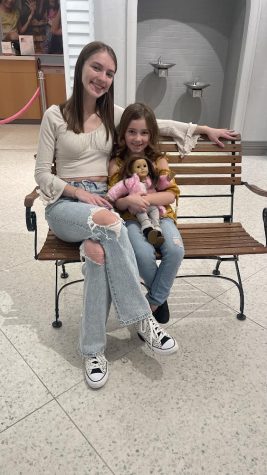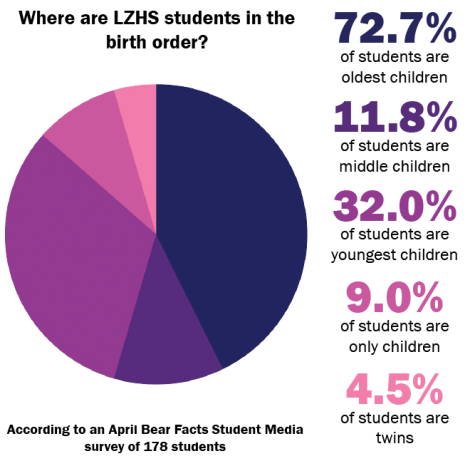Busting myths of birth order
Exploring birth order placements and it’s effects on childrens’ behavior and development
The third parent

Skylar Loeb-Stanko, senior and oldest child of four, believes her birth placement has made her a more caring person because of the additional parental role she has taken on with her siblings.
“I’m such a mother,” Loeb-Stanko said. “I don’t make bad decisions, I’m always giving out advice. I feel like I’m the parent of my friend groups […] and I’m always quick to offer advice or comfort and to be the responsible friend.”
However, Loeb-Stanko believes this extra responsibility of taking on a motherly role for three young girls has led to extra pressure being placed on her from a very young age.
“I feel like a lot of our [family] problems have been put on me since I was young. It’s really stressful because I have a million other things [to do], but I’m always thinking about what’s going on at home and if I’ve taken care of everything [there]. There was a time when my mom went out of town for a week so I was at school wondering if [my dad] knew where he [and my sisters] had to be [at any given time],” Loeb-Stanko said. “When my mom was gone, I stepped into [that role].”
This has led to a yearning for freedom, Loeb-Stanko says, as she has often felt trapped in her home growing up and like she is unable to be her own person apart from her eldest sister role.
“I’m really hungry for independence,” Loeb-Stanko said. “I love [my younger sisters] to death and I wouldn’t [trade them] for the whole world […] but I’m excited [to go to college next year] and to be my own person.”
Stuck in the middle

For Mia McHugh, sophomore and middle child, she believes she has gotten the best of both worlds being a middle child, having had very different yet strong relationships with both of her siblings throughout her childhood.
“It’s nice to have an older sibling as a role model and to be able to be the role model for my younger brother,” McHugh said. “Being in the middle of my siblings has given me a lot of different opportunities [in my life].”
One of these opportunities, according to McHugh, is the ability to adjust to her audience.
“I know how to change my point of view because I have a different relationship with my older and younger siblings, so when I’m interacting with people that are older than me or younger [than me] I know how to switch those points of view and be able to interact with people of different ages since I’ve experienced both,” McHugh said.
A similarity in these relationships, though, is her closeness with both of her siblings, and though this provides wonderful relationships with her family, according to McHugh, it is also a big downside of being a middle child at certain times.
“I was able to build [amazing] relationships with both [of my siblings], which I think is a little harder for my older sister and younger brother to have with each other, just because of the age gap [between them],” McHugh said. “But at the same time, since I’ve built these really good relationships with both of them, I think it’s going to be a lot harder for me to say goodbye to my sister when she goes to college and to say goodbye to my brother when I [move away from home]. It will be harder for me to move on from my childhood.”
Following in the footsteps

Katherine Chialdikas, sophomore and youngest child, has discovered both positives and negatives to her placement in the birth order. Being the youngest of four children, Chialdikas says her siblings were her main role models growing up.
“Being the youngest sibling is impactful because you grow up watching your siblings to see how you should be acting in life,” Chialdikas said.
Other than having them to look up to throughout her childhood, Chialdikas says her relationships with her siblings evolved into more of a close friendship as they all got older.
“I have a fantastic relationship with all of my siblings,” Chialdikas said. “It’s very loving, very open and truthful [because] when they grew up, they gained so much more maturity, and now they’re reaching out more and they understand important their family really is to them.”
However, being a youngest child comes with its occasional faults, according to Chialdikas.
“When you’re a youngest sibling, the standards are different for you,” Chialdikas said. “When I don’t meet the same type of success that my siblings did [at my age], especially when it comes to school or sports, my parents will often respond negatively and I’ll beat myself up over it too.”
Because of feelings like this, Chialdikas has found it important to be independent and learn to separate herself from her siblings.
“Growing up, I was very codependent with my siblings,” Chialdikas said. “But as I got older, and especially when I reached high school, I started to recognize that not everything I do in my life has to involve my older siblings [or have their influence] and that I am my own person.”

The one and only
Some might say a sibling is like a built in friend; however, for only child, Maddie Kim, freshman, she lacks this connection.
“I’ve tried to make more friends [later in life] because I don’t have built-in ones from my family,” Kim said.
However, her lonely childhood led to Kim creating stronger relationships with her friends later in life, sometimes, even as surrogate siblings.
“When I was younger, I was really bored all the time [without any other kids at home],” Kim said. “So I’ve always treated my friends like they were my siblings.”

As a senior, this is Sadie’s third year on the Bear Facts staff, and is excited to act as the Print Editor-In-Chief for the 2024-2025 school year. Though...
